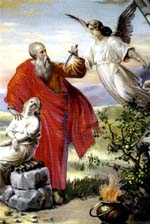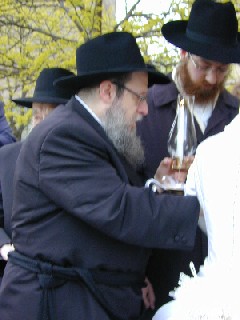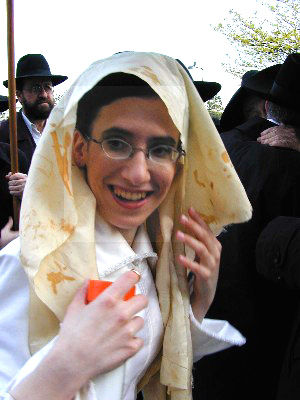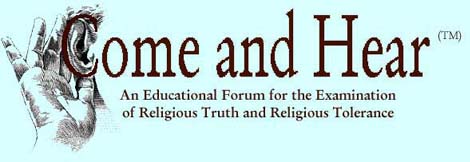
Blood Ritual | |||||||||||||||||||||||||||||||||||||||||||
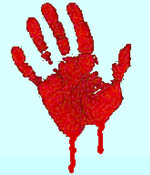 Blood Ritual: — Blood ritual is fundamental to Judaism. Some blood sanctifies, some blood defiles. Let's see what the Talmud doctrines are.

The Destroyer Passes Over 
The Battle of Joshua with Amalekites by Poussin (17) 
You can help in the battle for Truth, Justice, and the American Way! Fight the forces of censorship and suppression of the Talmud, and bring about understanding between peoples of different faiths. 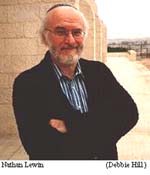 Nathan Lewin, a prominent Washington lawyer who has argued at least 27 cases before the US Supreme Court, has written an immodest proposal to end the "suicide bombings" in Israel. To this practitioner of due process in the United States, the pragmatic approach to this Israeli problem is to slaughter ("execute") the family members of anyone accused of a bombing, without resort to judicial procedure. He would like the US to join with Israel in this policy. (8) 
Rabbi Arthur Green, historian of Jewish religion and theologian, is Professor of Jewish Thought at Brandeis University. Rabbi Green wrote an essay in opposition to Nathan Lewin's immodest proposal, beginning his essay with the words, "Although I am not as pious as Nathan Lewin …" (9) Despite his awesome credentials and the prestigious invitation to represent the opposition in Shma Magazine, Rabbi Green does not base his arguments on Old Testament or Talmud law. In the same essay, Rabbi Green wrote: 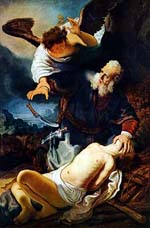
Abraham's Sacrifice, by Rembrandt, 1635 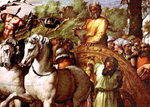
David (as King) Takes Captives 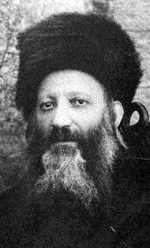
Rabbi Avraham Yitzhak HaCohen Kook (1865-1935) was a preeminent Talmudic scholar and a Lurian Cabbalist. 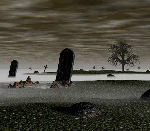
A Way of Life in Ancient Israel 
Old horse-drawn harrow (from an antique pub sign) 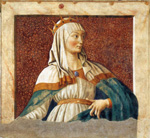
Queen Esther by Italian master Andrea del Castagno (18) 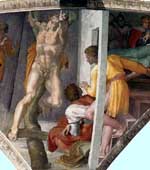
Punishment of Haman by Michelangelo (16) 
Symbolic Cannibalism 
Celebration of Purim 
Deborah Lipstadt is a professor of modern Jewish and Holocaust studies at Emory University. She also works with the U.S. Holocaust Memorial Museum. |
A dominant theme of both ancient Hebrew and subsequent Jewish culture is the Holy Atrocity. The ancient Hebrews, most often acting upon direct orders from LORD God, exterminated entire ethnic groups, tribes and nationalities. Men, women, children, and livestock were slaughtered, cities burned, and artwork destroyed. Sometimes LORD God directed the Hebrews to massacre each other, and sometimes others attacked LORD God's people. (26) Advocating Holy AtrocitiesThe Holy Atrocity is relevant to today's political situation in the Middle East and the role America will play: The Holy Atrocity is advocated as a political solution. One of the advocates is Washington, DC lawyer Nathan Lewin, who represents Orthodox Jewish interest groups in high-profile legal disputes. In an article published in May 2002 in the opinion magazine Shma.com, Lewin called for the massacre of families of Palestinians accused of suicide bombing. He introduces the subject with these words: What if Israel and the United States announced that henceforth the perpetrators of all suicide attacks would be treated as if they had brought their parents and brothers and sisters with them to the site of the explosion? — Nathan Lewin (8) We encountered Lewin before when he submitted an amicus curiae brief to the Supreme Court arguing that the US death penalty is cruelly inflicted, and that the US should emulate the humanitarian death penalty principles contained in the Talmud. (35) Lewin also argued that the death penalty was rarely used in Talmud law. We found a number of flaws in Lewin's presentation — for example, he failed to tell the Supreme Court about a Talmud law that mandates the annihilation of entire tribes, towns, and cities in one fell swoop. (Note: In the following Talmud excerpts, we sometime omit footnotes and non-germane text. Omitted text is indicated by an ellipsis (…). The full text and the footnotes are accessible through the link that follows the excerpt, along with the text of the entire tractate. Now, at Come and Hear™, you can judge the Talmud in context.) MISHNAH. … A TRIBE … CAN ONLY BE TRIED BY A COURT OF SEVENTY-ONE … NO CITY CAN BE DECLARED CONDEMNED SAVE BY A DECREE OF A COURT OF SEVENTY-ONE. A FRONTIER TOWN CANNOT BE CONDEMNED NOR THREE CITIES AT A TIME, BUT ONLY ONE OR TWO. — Babylonian Talmud, Tractate Sanhedrin 2a For the full text of this Mishnah, see the Appendix A: Mishnah of Sanhedrin 2a. In his Shma.com article, Lewin asks a tough question and answers it. … Finally, can Jewish law and tradition accept this seeming punishment of innocents? The Torah commanded the total eradication — including woman and children — of certain nations (Amalek being a singular illustration) because of the continuing threat its members presented to the survival of Israel. When there is no other deterrent, self-defense entitles one to take measures that are ordinarily unacceptable. — Nathan Lewin (8) A Weak RebuttalSo then, innocent men, women, and children would be slaughtered whenever Israel accuses one of their relations of a suicide bombing attack. Along with Lewin's article, Shma.com published an opposition piece written by Rabbi Arthur Green, who is a historian of Jewish religion, Professor of Jewish Thought at Brandeis University, and a former dean and president of the Reconstructionist Rabbinical College. Green had the task of explaining why slaughter of the innocent is not a Jewish solution. Green grabs the moral high ground, claiming he — not Lewin — is on the side of traditional Judaism. Although I am not as pious as Nathan Lewin, I still have some pretty old-fashioned Jew-ish instincts. My first desire on reading Lewin's essay was to rayz kri'ah, tear my garments, as a sign of mourning on hearing the desecration of God's name. Can we really have come to this? A well-respected spokesman for law, ethics, and Jewish tradition proposes that we (the government of Israel, that is, the one he would like to see operating on Torah-based principles) execute the families of suicide bombers. Devoting all of six words to the struggle of conscience ("This is no easy ethical question …"), he goes on to justify his proposal by reference to the Torah's command to eradicate Amalek and the Canaanite peoples. I only wonder how long it will take him, by the force of this proof-text, to go all the way and suggest that the Palestinian nation as a whole has earned the fate of Amalek. After all, "when there is no other deterrent …" — Rabbi Green (9) In arguing that Jewish tradition does not support the massacre of the innocent, Rabbi Green refers to one of Israel's oldest and most celebrated massacres: the annihilation of the Amaleks — men, women, and children. (14) But Rabbi Green's most memorable statement is this: The Jewish tradition's most essential moral teaching, that every human being is the image of God, must not fall victim to the bleak times through which we are living. — Rabbi Green (9) Understandably, Rabbi Green does not refer to the Sanhedrin 2a massacre doctrine when countering Lewin's arguments. Instead, he gives the impression that, according to Jewish tradition, all people have equal worth. But in fact the Talmud Jewish tradition assigns permanent underclass status to non-Jews. We have reviewed these Talmud laws (or traditions, to use Rabbi Green's words) in Talmud v. US Law. Rabbi Green did not cite his sources, so we cannot examine his references in their original contexts. As we point out in Critical Words of Talmud Study and Really, Really Kosher Sex, Jewish religious tradition, arising from its Kabbalistic nature, comfortably incorporates contradictions. A polemicist is free to choose whichever teaching suits his target audience and represent it as "Jewish tradition." But since, according to so many experts, the Talmud is the Word of God, the basic book of Jewish law, and the foundation of Jewish culture, (20) we will be examining the doctrines of the Talmud; and because the Talmud massacre laws cite Old Testament law, we will review Old Testament law, too. Annihilation of IdolatersIn the following, a "seduced city" is one where the residents were formerly Jews, but have now taken up another religion. MISHNAH. THE FOLLOWING ARE DECAPITATED: A MURDERER, AND THE INHABITANTS OF A SEDUCED CITY. — Babylonian Talmud, Tractate Sanhedrin 76b Recall that, according to Talmud's Jewish tradition, "idolatry" does not necessarily entail worshipping idols. Non-Talmudic Jews have, from time to time, been designated idolaters (see Critical Words of Talmud Study: "Old Testament Believers Labeled Idolaters" [39]). And Christians are certainly considered idolaters (see America's New Government Church [40]). The theme of annihilating the residents of a seduced city is picked up again in Sanhedrin 111b, included in full as Appendix B: Mishnah of Sanhedrin 111b. Here is a key excerpt: MISHNAH. THE INHABITANTS OF A SEDUCED CITY HAVE NO PORTION IN THE WORLD TO COME, AS IT IS WRITTEN, CERTAIN MEN, THE CHILDREN OF BELIAL, ARE GONE OUT FROM AMONG YOU, AND HAVE WITHDRAWN THE INHABITANTS OF THEIR CITY. — Babylonian Talmud, Tractate Sanhedrin 111b Sanhedrin 111b is based on Deuteronomy 13:12-16.
— Deuteronomy 13:12-16 (KJV) Under the Old Testament system of law, there is no freedom of religion. On the other hand, life is simple: worship Yahweh or die. Talmud RevisionismThe Talmud Sages revise this Old Testament law by admitting of certain exceptions. Sanhedrin 111b continues in this vein: MISHNAH. … THEY ARE NOT EXECUTED UNLESS THE SEDUCERS ARE OF THAT CITY AND THAT TRIBE, AND THE MAJORITY THEREOF ARE SEDUCED, AND THE SEDUCERS ARE MEN. IF WOMEN OR MINORS SEDUCED IT, IF A MINORITY WERE SEDUCED, OR IF THE SEDUCERS WERE FROM WITHOUT THE CITY, THEY ARE TREATED AS INDIVIDUALS, AND TWO WITNESSES AND A FORMAL WARNING ARE NECESSARY FOR EACH [OFFENDER]. — Babylonian Talmud, Tractate Sanhedrin 111b The Mishnah continues with the Deuteronomy hardline and Talmudic revisions. Following the Mishnah, the Gemara continues for many pages, seeking exceptions to the Divine commandment of Deuteronomy, whereby the law would not apply or could not be applied as written. R. Simeon b. Yochai (38) is identified by name in the latter half of the Mishnah, declaring the holy, sacrificial nature of this atrocity, as follows: MISHNAH. … MULTITUDES ARE DECAPITATED; HENCE THEIR POSSESSIONS ARE DESTROYED. … R. SIMEON SAID: THE HOLY ONE, BLESSED BE HE, DECLARED, IF YE EXECUTE JUDGMENT UPON THE SEDUCED CITY, I WILL ASCRIBE MERIT TO YOU AS THOUGH YE HAD SACRIFICED TO ME A WHOLE OFFERING. AND IT SHALL BE A HEAP FOR EVER. — Babylonian Talmud, Tractate Sanhedrin 111b Rabbi Steinsaltz on Holy AtrocitiesCommenting on Chapter XI of the Sanhedrin (containing folio 111b), Talmud scholar Rabbi Adin Steinsaltz states that Chapter XI fills in the picture of Jewish existence with respect to faith. His concluding remarks may be summarized as follows: An idolatrous city never did happen and never could happen, but if it did, the Sanhedrin 111b response would be correct. The figures described lived in the past, but in various forms they are eternal types, and they offer a warning for the future. — Rabbi Steinsaltz (27) While denying any historical application, Rabbi Steinsaltz endorses the policy and the principle behind the policy — he endorses the death penalty for non-conforming Jews. Rabbi Steinsaltz is a winner of Israel's prestigious Israel Prize. Old Testament Holy AtrocitiesFor some, it is easy to blame the Talmud, but difficult to acknowledge the roots of unpleasant Talmud doctrines in the Old Testament. For example, consider this remark from one contemporary Talmud critic: "For true Jews there is only one divinely-inspired book, not the Talmud! The Bible liberates, the Talmud enslaves." While this statement may satisfy some who call themselves Christians, it does not serve the truth. We have just seen that the "Bible" — that is, the Old Testament — threatens death to Jews who adopt another religion. In what sense, then, does the Bible "liberate"? If the Old Testament is a Divinely-inspired book, one must wonder at the nature of the Divine. Here is a partial list of Holy Atrocities in the Bible, excerpted from In His Own Image. Numbers are for ease of reference only, with no other significance.
Celebrating AtrocitiesIn Exodus 12:12-14, we saw that LORD God ordered the ancient Hebrews to celebrate His slaying of the firstborn of Egypt "forever." Jews commemorate the event as Passover. Another Biblically reported massacre is the Feast of Purim. An entire tractate of the Talmud, Tractate Megillah, is devoted to prescriptions for its observance. Soncino Talmud translator Maurice Simon explains: The tractate Megillah, as its name indicates, in concerned primarily with the Book of Esther — its place in the liturgy and its interpretation. It begins by fixing the various days on which the Megillah is to be read in order to commemorate the miracle of Purim. — Maurice Simon (2) The Essential PurimThe Purim event is thought to have taken place in 474 B.C. in the Persian Empire. During this time, Jews were scattered among the people of all the other races. Chapters 1 and 2 of the Book of Esther do not mention any problems between Jews and Gentiles in the Empire. We do, however, learn that King Ahasuerus is married to Queen Esther, and that Esther has kept secret from the king the fact that she is Jewish on the instructions of her cousin Mordecai. Then in Chapter 3, Mordecai violates Persian law by refusing to bow to Haman, the king's Grand Vizier. This was a public insult and a challenge to Haman (Esther 3:4). Given that his cousin was queen of the Persian Empire and a Jew, Mordecai's motives are open to question. Though reminded daily by the royal officials of his duty, Mordecai continues to flout the law and tells them that he is a Jew. By his actions, Mordecai puts the Jews in mortal danger, but he holds a secret trump card — his cousin Queen Esther.
— Esther 3:1-9 (KJV) In verses 9 and 10, Mordecai asks the king to sign a decree for the destruction of the Jews, and the king agrees. Let us review what we have learned so far:
Sometimes defenders of Mordecai claim that he refused to bow to Haman because Jews do not bow to anyone but LORD God. Even a brief examination of the Old Testament proves this statement wrong. Many G-dly Hebrews bowed to each other and to kings. Our short list includes these:
Sometimes defenders of Mordecai claim that bowing was Haman's whim. Verse 2 clearly indicates that "the king had so commanded." Sometimes defenders of Mordecai claim that only the king's servants were required to bow. Whether Mordecai was a "servant" or a subject of the king is a distinction without a difference: the king's servants clearly understood the king's orders, and it was they, not Haman, who first noticed Mordecai's disobedience and attempted to correct him (verse 3). Let's keep these points in mind and return to the Purim story. Mordecai's cousin, Queen Esther, queen of the Persian Empire, is secretly Jewish. Palace intrigue leaves Mordecai and Esther with the upper hand, and Haman is deposed and hanged. The king gives to Esther the estates of Haman (Esther 8:1), and to Mordecai the royal signet ring (Esther 8:2). Mordecai writes a proclamation in the king's name, permitting the Jews in every city to kill anyone who might assault them — and, as usual, to kill the women and children. Mordecai's order authorizes the Jews to plunder the property of the victims (Esther 8:11).
The slaughter goes forward as planned, but inexplicably, the Jews refrain from plunder. The Jewish Encyclopedia presents this account: Before the day set for the slaughter arrived a great number of persons, in order to avoid the impending disaster, became Jewish proselytes, and a great terror of the Jews spread all over Persia. — Jewish Encyclopedia (3) The Book of Esther (Esther 9:12) tells us that on the first day of the slaughter 500 men were slain in the capital, and an unstated number in ten other cities. Esther 9:15-16 tells us that, on the second day of slaughter, 300 were killed in the capital and 75,000 were killed in the other cities. Esther's ChoiceLet us consider Esther's situation. She is the Queen, responsible for the welfare of her subjects; she is not a private citizen. After Haman is deposed, Esther has a choice. She has a wonderful opportunity to show the true mettle of the Jewish religion and the Jewish people. She could be magnanimous in victory; surely no harm could come to the Jewish community, as the King and his army are at her disposal. Here is a chance for the Jews to be truly a light unto nations. (see Isaiah 49:6, Isaiah 51:4, Isaiah 60:3) But Esther could also use her power and position to take revenge on the powerless. What does Esther do? Esther chooses to take revenge, thereby reinforcing a negative stereotype of the Jewish character. The Frontier of FireOne is reminded of Dr. Abraham Cohen's words, when he wrote so admiringly of the leadership of Ezra, and the "frontier of fire:" History, which is largely a record of the melting of minorities in majorities, records no instance of the survival of a group not segregated in space or not protected by a burning faith as by a frontier of fire … If, then, the Jewish nation was to be preserved, it must be ringed round "by a burning faith as by a frontier of fire" … — Rev. Dr. Cohen (7) Perhaps the Feast of Purim is one such "frontier of fire." Let us see how Jewish leadership has managed this event through the millennia. Life Is What You Make ItConsider the Purim episode from the Jewish viewpoint. According to the Book of Esther, the Jews and Gentiles were not at odds before Mordecai publicly flouted the king's law, demonstrated a rebellious attitude, and flaunted the word "JEW." After Haman was hanged, King Ahasuerus gave Esther and Mordecai enormous power. If Jews believe King Ahasuerus' actions were righteous, Purim could be a celebration of a Gentile king. Jews could condemn Mordecai's lawlessness and deliberate provocation of Haman — provocation that put the Jews in mortal danger. Instead, they choose to memorialize Haman as the prototypical villainous Gentile of all time, and celebrate Mordecai and Esther as heroes. They choose to celebrate hatred. The Quality of CelebrationDuring Purim festivities, the book of Esther is read and the audience boos, hisses, and uses noisemakers to drown out the name of Haman whenever he is mentioned in the text. There is a lavish feast with plenty of wine. The Talmud Sages encourage Jews to get drunk and to engage in a Bacchanalia: GEMARA. … Raba said: It is the duty of a man to mellow himself [with wine] on Purim until he cannot tell the difference between 'cursed be Haman' and 'blessed be Mordecai.' — Babylonian Talmud, Tractate Megillah 7b Along with memorializing Haman's villainy, Purim celebrates the slaughter of the Persian Gentiles as a joyful event. Some Gentiles who understand the nature of the Purim incident are uncomfortable with this. Symbolic CannibalismAshkenazi Jews commemorate Purim by eating pastries fashioned to resemble Haman's hat ("hamentashen" in Yiddish). Sephardic Jews eat Haman's ears ("Haman's Ears," "oznei Haman" in Hebrew, or "orejas de haman" in Spanish). Rabbi Robert Sternberg has a recipe for Haman's Ears in his cookbook, The Sephardic Kitchen: The Healthy Food and Rich Culture of the Mediterranean Jews. … At Purim, to celebrate the demise of the hated Haman, the Sephardim make pastries in the shape of his ears and the Ashkenazim make pastries in the shape of his 3-cornered hat. There are different types of dough, including a yeast dough. This biscuity one is meltingly delicious. There are various fillings. The most traditional and most popular is a poppy-seed one. Another is with prunes. — Rabbi Steinberg (5) Most cultures forgive and forget their wars within a century, permitting the spirits of their enemies to evaporate into history and burying the bodies in peace. To this writer's knowledge, none of them eat pastry effigies — whether ears or hats — of an enemy killed thousands of years in the past. None of them celebrate the needless slaughter of others. Hatred "Ticks"The Jerusalem Post cartoon strip, "Drybones," explained the 1999 Purim celebration with an illustration and text that reads, in part: Obviously the saving of one Jewish community in ancient Persia is not what makes the joyous Purim holiday so significant. And the characters of "Queen Esther" and "Mordechai the Jew" are NOT what makes the holiday tick. — Jerusalem Post (6) Note the above words: "And recognizing the sly Haman who wants to destroy us is important, because there seems to be a Haman in every generation." It seems very important to Jewish leadership that Jews be hated. Is being hated yet another "frontier of fire" that supplies the cohesion for Jewishness? Rabbi Schneerson and Purim RevisionismThe Lubavitcher Rebbe, the late Rabbi Menachem M. Schneerson, in a Purim message to his supporters, echoed Reverend Dr. Cohen's thoughts: The story of Purim, as related in the Book of Esther, gives us a clear analysis of the 'Jewish problem.' — Rabbi Schneerson (34) The Book of Esther and the origin of Purim does perhaps give us a clear analysis of "the Jewish problem," but Rabbi Schneerson misses it. Rabbi Schneerson asserts Haman just picked on the Jews because they were different: "Haman, the enemy of the Jews, recognized the essential qualities and characteristics of the Jews … 'their laws are different from those of any other people' (Book of Esther 3:8)." But Rabbi Schneerson blots out the memory of Esther 3:1-6, wherein we learn that Mordecai deliberately disobeyed King Ahasuerus's command, deliberately insulted the Grand Vizier, and ignored the repeated attempts of others to reform his behavior. In short, Mordecai broke the law of the land and showed contempt for the rulers — and that doesn't fly in anybody's country, regardless of who you are. Mordecai did this while asserting his Jewishness. Rabbi Schneerson would have us forget that Mordecai created a potentially deadly situation for his own people. In short, Rabbi Schneerson would have us remember only the antipathy of the Gentile, but he would have us forget that the antipathy was deliberately provoked by the Jew. Why Embroider the Tale?The Union of Orthodox Jewish Congregations of America ("Orthodox Union") embroiders the Bible story with this version of events: Haman was a Megalomaniac who wanted the Persian throne for himself. Notice the Orthodox Union's delight in describing the fate of Haman, and his presumably innocent sons. "Haman" — the evil Persian megalomaniac, who saw in the Jewish People and in Mordechai, in particular, the block in his path to the throne of Persia. To get rid of this "obstacle," he formulated a plot, based on a lottery (a "Pur," in Persian), by which he would effectively exterminate the entire Jewish population. Fortunately, at that time, we were able to assemble enough "zechut," or merit, to convince HaShem that we were still worthy of being saved. — Orthodox Union (41) This allegation concerning Haman's ambitions is not supported by the Book of Esther, yet the Orthodox Union presents the detail as uncontested fact. What is the purpose of embroidering the tale? Does his death require further justification? Perhaps. On reading closely, we see that Haman was pleading for his life before Queen Esther in Chapter 7, verse 7. In verse 8, we learn that in the process of pleading for his life, Haman (inexplicably) "was fallen upon the bed whereon Esther was." The king chose this very moment to re-enter the banquet hall, and jumped to the conclusion that Haman was assaulting Esther. Sadly, Esther kept her silence and allowed Haman to be hanged on the basis of the false accusation.
— Esther 7:6-10 (KJV) Children Learn What They LiveRabbi Schneerson alludes to the modern Frontier of Fire, the Holocaust. The Holocaust is the leading Article of Faith in contemporary Judaism; it is to the Jews as the Crucifixion is to Christians. In the history of the world, nothing like the Holocaust has ever happened to any other people. The Holocaust must be viewed as a unique event in human history, an attempt to eradicate the idea of Judaism, as well as the Jews. — Erich Kulka (29) Independent researchers ("Holocaust revisionists") who question the official Holocaust story have been vilified, ruined, and imprisoned throughout the world. (37) Jewish leadership cannot allow rank and file Jews to entertain the notion that they are not hated. Jews must be hated. It is part of the mythos. To suggest that Jews are not hated is to express hatred of Jews. The trap of the Jewish atrocity mythos consists of two sets of beliefs:
The Jewish Encyclopedia states: The vast majority of modern expositors have reached the conclusion that the book [of Esther] is a piece of pure fiction … — The Jewish Encyclopedia (4) Despite this consensus of the "vast majority of modern expositors" (The Jewish Encyclopedia was published 1901-1906), the message has not being passed along by the Jewish leadership to the rank and file. Purim is an object lesson — in hostility unto death, and the Holy Atrocity. Having been prepared by Purim celebrations since childhood, the Holocaust is easy to accept. Jews Not Slaughtered HereAttorney Nathan Lewin, who wants the United States to join with Israel in massacring Palestinian families, is assisting Buffalo Law School professor Rabbi Noson Gurary to set up the National Institute for Judaic law. (10) The purpose of the Institute is to inject Talmud law into US courts and US society. In the same month that Lewin called for the massacre of Palestinian families, his colleague Rabbi Gurary gave his daughter away in marriage. Nathan Lewin may well have been a guest at the wedding. An article about the wedding of Devorah Leah Gurary and wedding photos were published the World Wide Web by Rabbi Gurary's organization, Chabad of Buffalo. (11) Rabbi Gurary, not this writer, makes his daughter's wedding a public event.
Rabbi Noson Gurary, father of the bride, leads his daughter in circling around the groom.
Rabbi Gurary's daughter after her wedding. Rabbi Gurary with his family, and millions of other Jews with their families, are safe here in America, enjoying the blessings of liberty. That is because the United States, a non-Jewish nation, permitted the Jews to come here and practice their religion openly. To Jew and Gentile alike, we extended our blessings and our principle of "Equal Justice Under law." In return, what do the Jews plan for us? See America's New Government Church, Talmud v. US Law, and other essays in America under the Talmud: Will It Work for US? Why Purim MattersAs America becomes more Talmudized, it is conceivable that American children will be expected to partake in this celebration of mass murder, and non-Jews may not be comfortable with this. America Is Rapidly Becoming Talmudized
In 1991, the US Congress declared the Talmudic Noahide Laws to be the basis "upon which our great Nation was founded" (see America's New Government Church). Under Noahide Law regulations, idolaters (which includes Christians by definition) are put to death. "Only an Internal Revolution …"The reader's eyes fall on the words of Martin Buber, a Jewish philosopher writing to Jews in 1961: Only an internal revolution can have the power to heal our people of their murderous sickness of causeless hatred. It is bound to bring complete ruin upon us. Only then will the old and young in our land realize how great was our responsibility to those miserable Arab refugees in whose fields we now sow and harvest; the fruit of whose gardens, orchards and vineyards we gather; and in whose cities we robbed, we put up houses of education, charity and prayer while we babble and rave about being the 'people of the book' and the 'light of the nations.' — Martin Buber (33) Buber's words apply to America. * * * Further reading:
Thank you for your consideration of the above,
NEXT: Blood Ritual 2: Animal Sacrifice and the Third Temple
Endnotes:
Appendix A: Mishnah of Sanhedrin 2aThe complete Mishnah for Babylonian Talmud, Tractate Sanhedrin 2a should be read in the Soncino original with the translator's footnotes. For those to whom the original is not available, the Mishnah text is reproduced here: MISHNAH. MONETARY CASES [MUST BE ADJUDICATED] BY THREE JUDGES; CASES OF LARCENY AND MAYHEM, BY THREE; CLAIMS FOR FULL OR HALF DAMAGES, THE REPAYMENT OF THE DOUBLE OR FOUR- OR FIVE-FOLD RESTITUTION [OF STOLEN GOODS], BY THREE, AS MUST CASES OF RAPE, SEDUCTION, AND LIBEL; SO SAYS R. MEIR. BUT THE SAGES HOLD THAT A CASE OF LIBEL REQUIRES A COURT OF TWENTY-THREE SINCE IT MAY INVOLVE A CAPITAL CHARGE. — Babylonian Talmud, Tractate Sanhedrin 111b Appendix B: Mishnah of Sanhedrin 111bThe complete Mishnah for Babylonian Talmud, Tractate Sanhedrin 111b should be read in the Soncino original with the translator's footnotes. For those to whom the original is not available, the Mishnah text is reproduced here: MISHNAH. THE INHABITANTS OF A SEDUCED CITY HAVE NO PORTION IN THE WORLD TO COME, AS IT IS WRITTEN, CERTAIN MEN, THE CHILDREN OF BELIAL, ARE GONE OUT FROM AMONG YOU, AND HAVE WITHDRAWN THE INHABITANTS OF THEIR CITY. THEY ARE NOT EXECUTED UNLESS THE SEDUCERS ARE OF THAT CITY AND THAT TRIBE, AND THE MAJORITY THEREOF ARE SEDUCED, AND THE SEDUCERS ARE MEN. IF WOMEN OR MINORS SEDUCED IT, IF A MINORITY WERE SEDUCED, OR IF THE SEDUCERS WERE FROM WITHOUT THE CITY, THEY ARE TREATED AS INDIVIDUALS, AND TWO WITNESSES AND A FORMAL WARNING ARE NECESSARY FOR EACH [OFFENDER]. IN THIS [THE PENALTY OF] INDIVIDUALS IS SEVERER THAN [THAT OF] A MULTITUDE, FOR INDIVIDUALS ARE STONED, THEREFORE THEIR PROPERTY IS SAVED; BUT MULTITUDES ARE DECAPITATED; HENCE THEIR POSSESSIONS ARE DESTROYED. — Babylonian Talmud, Tractate Sanhedrin 111b | ||||||||||||||||||||||||||||||||||||||||||
Footnotes:
Full specifics for each of the printed sources are provided in the Bibliography. Outside URLs were valid at the time this article was written. However, be mindful that URLs do change.
- "Purim.com," The Jewish Web: http://www.purim.com/facts.shtml cached at http://www.come-and-hear.com/editor/cp-purim
- Babylonian Talmud, "Introduction," by Maurice Simon, Tractate Megillah, page v
- The Jewish Encyclopedia, s.v. "Esther," Vol. V, page 233 available at http://jewishencyclopedia.com/view.jsp?artid=483&letter=E
- Ibid, page 235-236
- "Hamantashen Recipes," eLuna.com: http://www.eluna.com/holidays/Hamantashen.asp cached at http://www.come-and-hear.com/editor/cp-hamans-ear
- "Purim 1999," Jerusalem Post: http://info.jpost.com/1999/Drybones/PURIM/ cached at http://www.come-and-hear.com/editor/cp-queen-esther-jp
- Everyman's Talmud, Rev. Dr. Abraham Cohen, page xxxv
- "Deterring Suicide Killers," Shma.com, May 2002, http://www.shma.com/may02/nathan.htm cached at http://www.come-and-hear.com/editor/br-lewin-shma
- "A Stronger Moral Force," Shma.com: http://www.shma.com/may02/arthur.htm cached at http://www.come-and-hear.com/editor/br-green-shma
- "Jewish law institute launched in DC," Jerusalem Post, November 9, 2002, http://www.jpost.com/servlet/Satellite?pagename=JPost/A/JPArticle/ShowFull&cid=1036830287246, now moved to http://pqasb.pqarchiver.com/jpost/index.html?ts=1042784008 cached at: http://www.come-and-hear.com/editor/cp-jp-11-09-2002
Also: "Jewish Law Comes to D.C.," The Jewish Week, January 8, 2003, http://www.thejewishweek.com/news/newscontent.php3?artid=7074 cached as http://www.come-and-hear.com/editor/cp-jw-01-08-03 - "Yosef Yitzchak Sirota and Devorah Leah Gurary wedding," Chabad of Buffalo: http://www.chabadofbuffalo.com/SGwed/SirGurwed.htm cached at http://www.come-and-hear.com/editor/br-gurary-chabad
- "In Defense of Dr. Laura," by Avraham M Goldstein, The Jewish Homemaker, http://www.ok.org/homemaker/tishrei61/person.html cached at http://www.come-and-hear.com/editor/na-jh-defense
- "Judaism - Purim," BBC Religion & Ethics: http://www.bbc.co.uk/religion/religions/judaism/holydays/purim/index.shtml cached at http://www.come-and-hear.com/editor/br-bbc-purim
- For information on the Amalek genocide of the Old Testament, see When Victims rule, Chapter 18 excerpt: http://www.jewishtribalreview.org/amalek.htm cached at http://www.come-and-hear.com/supplement/cp-amalek.html. Complete work online at http://www.jewishtribalreview.org/wvr.htm
- See http://www.nationalreview.com/kopel/kopel120502.asp for historical background, or any number of other sites locatable through an Internet search portal.
- Detail from Punishment of Haman by Michelangelo di Lodovico Buonarroti Simoni, 1511, Cappella Sistina, Vatican. Michelangelo portrayed Haman crucified rather than hanged as is told in the Biblical Book of Esther
- Detail from The Battle of Joshua with Amalekites, by Nicolas Poussin. c. 1625. Oil on canvas. The Hermitage, St. Petersburg, Russia
- Queen Esther, by Andrea Del Castagno, Florence, c. 1495
- Accusation and Trial: "Level of Proof" is available at http://www.come-and-hear.com/editor/capunish_2.html#presumption
- See Critical Words of Talmud Study and More Critical Words of Talmud Study. See also "Jewish Law and the Supreme Court: Happy Millennium From an Ancient Legal Tradition," Project Next Step by Rabbi Yitzchok Adlerstein, http://projectnextstep.org/adlerstein-articles/jewish-law-supreme-court.htm cached at http://www.come-and-hear.com/editor/cp-adlerstein2
- Rabbi Yitzchok Adlerstein, director of the Jewish Studies Institute of Yeshiva of Los Angeles, chair of Jewish Law and Ethics at Loyola Law School, and director of Project Next Step at the Simon Wiesenthal Center: http://www.jewishjournal.com/old/deathpenalty2.3.10.0.htm cached at http://www.come-and-hear.com/editor/cp-adlerstein
- Babylonian Talmud, Tractate Sanhedrin 71b, page 486, note 5, available in Come and Hear™ hypertext as Sanhedrin 71b, note 12, http://www.come-and-hear.com/sanhedrin/sanhedrin_71.html#71b_12
- Hoffman
- Rabbi Kook Books, http://www.rabbikookbooks.com/war%20and%20peace.html cached at http://www.come-and-hear.com/editor/br-kook
- War and Peace by Rabbi Avraham Yitzhak HaCohen Kook, as quoted by Rabbi Kook Books, http://www.rabbikookbooks.com/war%20and%20peace.html cached at http://www.come-and-hear.com/editor/br-kook
- With the help of some other researchers, we have collected an anthology of illustrative passages from the Bible. See In His Own Image at http://www.come-and-hear.com/supplement/ot-select.html
- The Talmud, The Steinsaltz Edition, Volume XXI, Tractate Sanhedrin, Part VII, page 209, 210
- Waco, Fresh Salt in the Wound http://www.public-action.com/SkyWriter/ZOA/980415/index.html
- Kulka, Erich: New Forms of Auschwitz Lies, The Voice of Auschwitz Survivors in Israel 37 (Jan 1987) 2-6, quoted by Holocaust Denial, A Selected Bibliography, prepared for the International Conference "The Dynamics of Antisemitism in the Second Half of the 20th Century" convened by The Vidal Sassoon International Center for the Study of Antisemitism, The Hebrew University of Jerusalem, Jerusalem, June 13-16 1999, http://sicsa.huji.ac.il/denial.html cached at http://www.come-and-hear.com/editor/br-h-unique
- Like Evolution prior to the Scopes trial, the subject is out of bounds for legitimate inquiry.
- Pentagon RESCUE? Open, Bloody, Questions …: "ADL and FBI Are Partners" http://public-action.com/rescue.html#adl-fbi-partners
- To understand the intensity of the Antisemitism Doctrine, a reader might go to the web site of the Anti-Defamation League (http://www.adl.org) and enter "hate" in the search window. There will be returned a wealth of articles, most of them to the effect that the Jews of the world are prime targets of hatred from non-Jews. There are many words in English to express the antipathy of one kind of person for another, but only one word tailored for a specific target of hatred — "anti-Semitism." Searching on "anti-Semitism" and "antisemitism" at an Internet search site returns more than a 100,000 entries, and the first few hundred are on Jewish sites. Possibly a convenient entry to the subject is the Antisemitism Research Resource http://ddickerson.igc.org/antisemitism.html, cached at http://www.come-and-hear.com/editor/br-dickerson
In researching the subject, the reader will find that some have subdivided antisemitim into four categories: General Antisemitism, Anti-Zionism, Other Contemporary Antisemitism, and The Holocaust. - Martin Buber, published in Thud's Ner, January/February 1961
- "What is the secret to our survival?" by Rabbi Menachem M. Schneerson, Lubavitcher Archives, http://www.chabadnews.us/Purim/Purim_letter.htm cached at http://www.come-and-hear.com/editor/br-rebbe-purim
- See Sentence and Execution at http://www.come-and-hear.com/editor/capunish_1.html
- "Papal Apology," The NewsHour with Jim Lehrer, PBS, Transcript, April 8, 1998, http://www.pbs.org/newshour/bb/religion/jan-june98/vatican_4-8.html cached at http://www.come-and-hear.com/editor/pbs-june98
- The reader may be interested in the following Holocaust Revisionist web sites:
- European Foundation For Free Historical Research http://www.vho.org/
- The Website of Carlos Whitlock Porter http://www.cwporter.com/
- The Barnes Review http://www.barnesreview.org/
- Dr. Ingrid Rimland's Zundelsite http://www.zundelsite.org
- Committee for the Open Discussion of the Holocaust http://www.codoh.com
- Institute for Historical Review http://www.ihr.org/ and related commentary: IHR: Is The Ship Sinking? http://www.vho.org/GB/c/GR/IHRCrisis.html and Is Mark Weber Really A Revisionist Publisher? http://www.jfkmontreal.com/weber.htm
- David Irving's Welcome to the World of Real History http://www.fpp.co.uk/
and related commentary: David Irving, Another False Prophet? http://www.jfkmontreal.com/d_irving_emails.htm - Homepage of Professor Arthur R. Butz (author of "The Hoax of the Twentieth Century.") http://pubweb.acns.nwu.edu/%7Eabutz/
- The Gas Chamber of Sherlock Holmes http://www.codoh.com/incon/inconstrtchdex1.html
- John Ball's Air Photo Evidence http://www.air-photo.com/
- L'Association des Anciens Amateurs de Rècits de Guerre et d'Holocauste http://abbc.com/aaargh/
- Wilhelm Tell Revisionismus http://www.ety.com/tell/revision.htm
- For more information on R. Simeon b. Yochai, see our introduction to The Zohar
- Critical Words of Talmud Study is available at http://www.come-and-hear.com/editor/critwords_1.html
- America's New Government Church is available at http://www.come-and-hear.com/editor/america_1.html
- (41)"Judaism 101: A Glossary of Basic Jewish Terms and Concepts: Haman," Orthodox Union, http://www.ou.org/about/judaism/di.htm#haman
© Copyright Carol A. Valentine, 2003. See copyright statement at http://www.come-and-hear.com/copyright.html
NEXT: Blood Ritual2 : Animal Sacrifice and the Third Temple
| Navigate This Site | |
 | |
| Home | |
| Valentine | |
| Dilling | |
| Talmud | |
| The Rabbis | |
| Supplement | |
| Glossary | |
| Download | |
| Admin | |
| | |
 Genuine Come and Hear™ CDs do not contain executable programs. When making CDs, do not include any files that end in .exe, .com, .bat, .vbs, .doc, .pif, .sit, or .scr. The person receiving the CD should use his own browser to view the files. This helps to protect him from harmful programs and viruses.
Genuine Come and Hear™ CDs do not contain executable programs. When making CDs, do not include any files that end in .exe, .com, .bat, .vbs, .doc, .pif, .sit, or .scr. The person receiving the CD should use his own browser to view the files. This helps to protect him from harmful programs and viruses. 